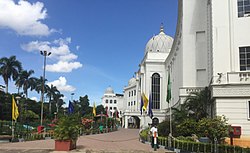Mohammed Fayazuddin | |
|---|---|
 | |
| Born | 22 September 1903 |
| Died | 1977 (aged 73–74) |
| Alma mater | Architectural Association School of Architecture |
| Occupation | Architect |
| Awards | Padma Shri (1977) |
Mohammed Fayazuddin Nizami (22 September 1903 - 1977) was an Indian architect and town planner. [1] [2] He was awarded the Padma Shri in 1977. [3]
Contents
Born in Hyderabad, he studied at the Sir J. J. School of Art in Mumbai and Architectural Association School of Architecture, England. He returned to India in 1934 and started working for the government of Hyderabad State. His major projects in Hyderabad include the State Bank of Hyderabad building (1952), Gandhi Bhavan (1956), Ravindra Bharathi (1961), and the Salar Jung Museum building (1968).









